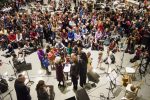When JArts asked me to write a blog for Hanukkah, I happily grabbed the microphone to talk about the MFA’s Judaica achievements since Dec. 13, 2017. Why Dec. 13? Because it was the day of last year’s big JArts/MFA Hanukkah bash, as well the eighth day of my new job (and the beginning of a brand-new life as a confused immigrant in the United States).
An awful lot has happened since. For a start, we have made 13 new acquisitions, which include two Iranian ketubot, an Indian Haggadah, a Kurdish Sabbath cloth, as well as Israeli feminist tefillin and tallit. And let’s not forget “Garden of Lights,” a beautiful Hanukkah lamp generously donated by Santa Fe-based silversmith Linda Threadgill.
In addition to expanding the collection, we have more than doubled the number of works on display in five new installations across the museum. As regular visitors to the MFA know, we intersperse Judaica with the rest of the collection, placing it side-by-side with other works from the same geographic region and period. Hopefully, JArts/MFA aficionados are already familiar with the Judaica displays in Gallery 142 (18th-century Judaica for the home) and with those in the American Wing’s 20th-century gallery (336) and 18th-century Newport gallery (127). These are still up and very much part of the Judaica MFA’s journey.
- But what is new this Hanukkah? Starting from the Sharf Visitor Center on the main floor is “Maccabees and the Hanukkah Story.” The two artists I chose to tell the celebrated deeds of the stubborn Maccabees are an unlikely pair: South End-born Jack Levine—of Boston Expressionism fame—and Ze’ev Raban, one of the most gifted and prolific members of the Bezalel School of Arts and Crafts in Jerusalem. While Levine’s black and white “Judas Maccabeus” conveys the hero’s determination through just a few, nervous lines, in Raban’s two exquisite watercolors the Maccabees seem to emerge from fairytale illustrations.
More works by Raban can be seen on the ground floor (just inside the Fenway entrance) in a glass case of metalwork Judaica by the Bezalel School. Founded in 1906, this is still the premier art school in Israel. Here we have put together Shabbat candlesticks, Hanukkah lamps and spice boxes made in Jerusalem in the 1920s. While their Diaspora-made predecessors mainly relied on Jewish symbols, these Jerusalem hanukkiot are embossed with narrative scenes. Often taken from the Book of Maccabees, the stories shown fostered not only religious belief, but also pride in a national homeland in the ancient land of Israel.
In nearby Gallery 144, and newly installed, are two beautiful paintings by Isidor Kaufmann and Edouard Brandon: “Hannah” and “Jewish Man Reading.” In both works, the two cosmopolitan artists express their nostalgia for a deeply traditional Jewish world, distant from their fast-moving cities of Vienna and Paris.
On the second floor, past a charming “Aleph-Bet” book and “A Poster for Bezalel” exhibition by our friend Ze’ev Raban (Gallery 248), visitors can venture in the immensely creative world of contemporary Judaica. In the Farago Gallery for Contemporary Craft (Gallery 258), we have just installed an entire case of works by Israeli and American artists, offering their own, innovative interpretations of Jewish ceremonial objects. The newly acquired “Garden of Lights,” for example, is displayed alongside Boris Bally’s striking “Man’orah.” Bally, who will be giving a meet-the-artist talk on Dec. 5, donated this work to the MFA in honor of his son’s bar mitzvah.
These unexpected Judaica creations would have probably not been born without the father of modernist Judaica, German-born Ludwig Wolpert. His Hanukkah lamp and Shabbat candlesticks are on the third floor of the American wing, perfectly at home in 1950s New York, and surrounded by works by other Jewish immigrant artists who changed the face of American design. Wolpert’s bold geometric forms and highly stylized Hebrew letters paved the way for a new generation of Judaica makers, who moved away from centuries-old decorative motifs toward increasingly linear forms and clean designs.
These displays are a testament to the versatility of Judaica—or “Judaicas”—spanning continents, centuries and a range of artistic idioms.
For more information on objects and locations, click here. Alternatively, ask for a printout of the “Judaica Objects on View” at the Sharf Visitor Center. Most importantly, come visit!
And Happy Hanukkah!
Find out more about the free Hanukkah: The Festival of Lights celebration at the MFA on Wednesday, Dec. 5, here.
Simona Di Nepi is Charles and Lynn Schusterman Curator of Judaica, Museum of Fine Arts, Boston.
Never miss the best stories and events! Get JewishBoston This Week.
This post has been contributed by a third party. The opinions, facts and any media content are presented solely by the author, and JewishBoston assumes no responsibility for them. Want to add your voice to the conversation? Publish your own post here.
MORE



